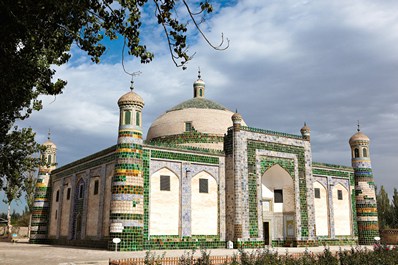The Mausoleum of Khoja Abajo - the best traditions of Uighur architecture
 Perhaps the most famous landmark of Kashgar is the Mausoleum of Abajo Khoja well-known in the East. This is not only one of the major Sufi shrines in Central Asia, with several spiritual leaders of East Turkestan of the XVII-XVIII centuries buried there, but also the final resting place of one of the most famous women in Chinese history.
Perhaps the most famous landmark of Kashgar is the Mausoleum of Abajo Khoja well-known in the East. This is not only one of the major Sufi shrines in Central Asia, with several spiritual leaders of East Turkestan of the XVII-XVIII centuries buried there, but also the final resting place of one of the most famous women in Chinese history.
The mausoleum located 5 km from the center of the modern city of Kashgar was built in 1640. Buried there are five generations of the family of Abajo Khoja, he, himself, his granddaughter -princess Iparhan (Syanfey/ Xiangfei) and another 70 family representatives of the Kashgar rulers. In addition to the mausoleum, the complex includes several mosques, gardens with ponds, a madrasah and a large Muslim cemetery, so the main part of the complex, except for the mausoleum and gardens are closed to tourists.
The mausoleum was built in the best traditions of the Uighur architecture: a square building with minarets in the corners of it and a domed roof. The exterior finish is very rich. The surface of the walls is covered with Dutch wares and tiles; the interior design is austere, and it is quite natural, because originally the mausoleum was built for the Sufis of one of the of Naqshbandi Order branches, Khoja
Abajo belonged to. Later, there were buried Kashgar rulers and their families. All the graves are covered with colorful bedspreads. The bedspreads for women differ from those of men only by a smaller size.
The mausoleum attracts not only the followers of Sufism and Muslim believers. Thousands of tourists come here every year to see the burial place of one of the most fatal women in Chinese history - Princess Syanfey or Uyghur Iparhan, who had been a favorite concubine of Emperor Qianlong from the Qing Dynasty for 28 years.
Iparhan was born in Kashgar, in the Khoja Abajo‘s family. According to a legend, she was one of the most educated women of that time, who also knew how to ride and was well-versed in weapons just as well as a man. On the eve of Kashgar conquest she was given in marriage, but her marriage did not last long. After the conquest of Kashgar in 1758, Iparhan was taken to the capital city of China, where she fell into the Emperor Qianlong’s harem.
Just from that moment, the most famous love story, which led China into disaster, began. When Emperor Qianlong saw Iparhan, he immediately fell in love with he, particularly, he liked the smell of her, and later Iparhan Syanfey got a Chinese name – the “fragrant concubine”.
Throughout her whole life in Forbidden City, Iparhan was homesick, so the amorous emperor spent huge sums of money on her every whim, built the castles and palaces which reminded her home, being unaware how his country was getting closer and closer to the approaching crisis. However, neither the love of Qianlong, no huge amounts of money, the emperor spent on her, helped the princess. Versions of her death are numerous: some believe that she committed suicide out of grief, and the others - that she fell victim of a rivals’ conspiracy.
After the princess’ death, the emperor ordered to transport her body to Kashgar. The funeral procession was accompanied by numerous servants, and as a legend has it, lasted about 3 years. One of the most famous, as the Kashgar people used to say, Uyghur princess was buried in the family mausoleum, together with her grandfather Abajo Khoja.

